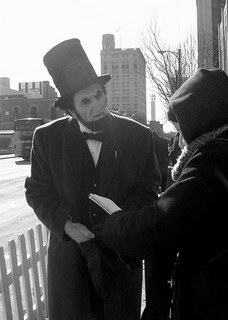Use a Dialogue Journal to Conduct Historical Interviews
Biff Barnes
“I wish I’d had a chance to ask _________ a few questions before they died,” is a thought that almost everyone writing about the past, whether a biographer, a narrative historian, a personal historian or a family historian has had. No matter how much research you do, there are always holes in the historical record, information you can’t find, questions you can’t answer. It’s frustrating. If only one could apply the techniques of the oral historian and interview someone who knew it would be so much easier.
Let’s look at a way to use a writer’s journal to do just that. Journaling is an open ended, uncensored, free writing technique in which a writer can answer questions about what they need to find out. Pat Darcy in her article Writing to Learn in The Journal Book describes the process as a conversation the writer carries on with herself. Suppose you took that idea one step further and made the conversation one in which you ask questions of that now dead source that you wish you could interview.
 Courtesy of Vanessa Roanhorse under Creative Commons
Courtesy of Vanessa Roanhorse under Creative Commons
How could you possibly know what they would say? It’s a speculative process, certainly. But, as a person who has researched the person you will be interviewing you have a considerable amount of knowledge of what they might think. As Darcy said, “…when writers think of writing, they think of a blank page – all the experience on which the writer is drawing in order to shape fresh meaning.” Think about your own experience. In your research you have encountered letters, diaries, newspaper accounts, and a wide variety of other sources of information about the person you’d like to talk to. They have, no doubt, led you to develop a sense of who the person was.
Informed speculation is one of the most important tools of creative nonfiction. Getting at what motivated a person or how they felt about an event helps bring the facts that can be documented to life. So use your journal to have a conversation with your subject Ask them the questions you want answered. Why did you choose to do that? How did it feel when you did? You already have a sense of what they might say. You’ll find their answers filling the pages of your journal.
You may not be completely satisfied with the result. That’s natural. Let the conversation rattle around in your unconscious mind for a few days. Then come back to your journal and ask for clarification. You’ll be surprised at the interesting insights you get in the process.
But wait, you say, I am supposed to make sure I’m writing about the facts. True enough. One way to deal with what is fact that can be documented and what is speculative is to make sure that you indicate when you are speculating. Let the reader know that you can’t document what will follow. What’s interesting is that your reader will appreciate the ideas you add if they grow organically and logically out of the facts you can document. Take a look at a history or biography that you like and you will see authors you hold in high regard doing exactly that.
The wonderful part of using a dialogue journal to conduct your interviews is that no reader ever needs to see them. When you feel you are ready take the ideas you’ve generated, polish them and include them in your book.